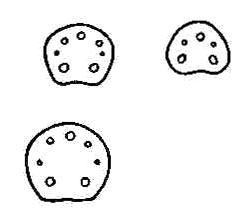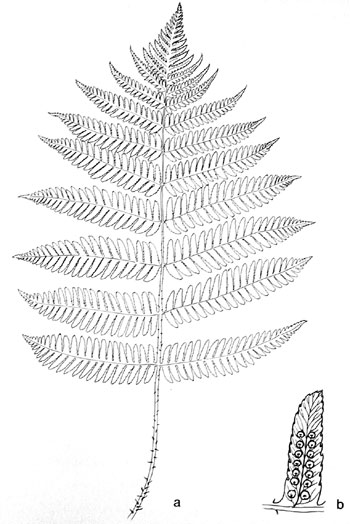| Dryopteris goldiana | ||
Goldie's fern, Giant wood fern | ||
|
Etymology
Goldiana is in honor of John Goldie, an early botanist who discovered this fern at Montreal, Canada
Description
Rhizome: erect, stout.
Frond: 120 cm high by 40 cm wide, deciduous, monomorphic, blade/stipe ratio: 3:2. Stipe: grooved, scaly at base; scales scattered, dark, glossy brown to nearly black, with pale border, vascular bundles: 7 in a c-shaped pattern at the stipe base, 5 -7 at the top of the stipe. Blade: 2-pinnate at base, ovate, tapering abruptly at apex, herbaceous, linear to ovate scales below, absent above. Pinnae: 15 to 20 pair, catadromous; pinnules basal pinnule equal to adjacent pinnules, basal basiscopic pinnule and basal acroscopic pinnule equal; costae grooved above, continuous from rachis to costae; margins crenate, or serrate; veins free, forked. Sori: round, in 1 row near the midrib, indusium: reniform, white to transparent when immature, shriveling, attached at a sinus, sporangia: lead gray, then dark brown or black, maturity: midsummer. Culture
Habitat: moist woods, especially ravines, limey seeps, or at the edge of swamps .
Distribution: northeastern North America.
Hardy to -35�C, USDA Zone 3.
Synonyms
Aspidium goldianum Hooker ex Goldie Thelypteris goldiana (Hooker) Nieuwland Nephrodium goldianum (Hooker) Hooker & Greville Lastrea goldiana Presl Polystichum goldieanum Keys. |
|
|

Dryopteris goldiana. Seven vascular bundles at the stipe base (below) and 5-7 at the top of the stipe. �Drawing from Ferns of Northeastern United States, Farida A. Wiley, 1936. |

Dryopteris goldiana. a) very broad frond, bright to dark green; b) fertile pinnule, serrate margin. �Illustration by V. Fulford from Ferns and Fern Allies of Canada, William J. Cody and Donald M. Britton, 1989, � Agriculture Canada, used with permission. |
